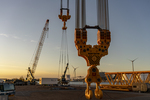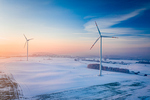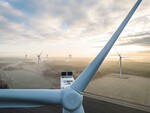News Release from WindEurope
Wind Industry Profile of
11/23/2007
Europe - Commission’s technology plan brings hope but lacks clarity
The European Wind Energy Association (EWEA) today welcomed the European Commission’s proposal on a Strategic Energy Technology plan. While the Plan acknowledges that wind energy is a key technology to meet the 20% renewables target, it still needs better focus, greater clarity and to set priorities.
The Commission’s proposal should be complemented by additional and more strategic measures and policies as suggested by the Portuguese presidency in its vision paper . These include a clearer distinction between the technologies already available today or in the final stages of development (onshore and offshore wind, 1st and 2nd generation biofuels, renewable heating and cooling, PV, concentrated solar power and smart grids) and technologies with an impact beyond 2020 (hydrogen and fuel cells, CCS, Gen-4 nuclear fission).
“The Commission’s Plan is a good basis for discussion at the Energy Council on 3 December. If complemented by the visions and additional measures presented by the Portuguese Presidency, there is hope for a positive outcome. Achieving the 20% renewable target depends on this, as does Europe’s future welfare. Europe has to prioritise investments now in efficiency, renewable energy technologies and infrastructure if we are to emerge successfully from the looming climate and energy crisis while reaping the commercial benefits of technology exports,” commented Christian Kjaer, EWEA Chief Executive.
EWEA agrees with the Commission that current energy research efforts – one-fourth of the level in 1980 - must be increased dramatically but regrets that the Plan does not address the continued need to reverse the irrational imbalances in national and EU research budgets. The wind energy sector would have liked to see a more detailed and clear financial strategy and priority-setting that takes into account past allocations of R&D funds between the different energy technologies. According to the International Energy Agency (IEA), less than 1% of government research expenditure since 1974 has been allocated to wind power, while nuclear power has received 60% or $175 billion.
EWEA supports the Commission’s twin-track approach of research to lower cost and performance combined with measures to stimulate market development. EWEA also supports the Commission’s call on the Member States, European Parliament and industry to develop collaborative research and better cooperation. The proposal for public and private partnerships to be launched in 2008 in the wind and electricity grid sectors could be another step in the right direction, but needs more clarity.
However, the proposal’s aim to “double the power generation capacity of the largest wind turbines” needs refinement. The size of individual wind turbines is not a goal in itself. It must be accompanied by measures to continue improvement in performance and reliability.
(1): Vision paper from the Portuguese presidency for EU Strategic Energy Technology Plan, to be debated at the Energy Council on 3 December: click here
The Commission’s proposal should be complemented by additional and more strategic measures and policies as suggested by the Portuguese presidency in its vision paper . These include a clearer distinction between the technologies already available today or in the final stages of development (onshore and offshore wind, 1st and 2nd generation biofuels, renewable heating and cooling, PV, concentrated solar power and smart grids) and technologies with an impact beyond 2020 (hydrogen and fuel cells, CCS, Gen-4 nuclear fission).
“The Commission’s Plan is a good basis for discussion at the Energy Council on 3 December. If complemented by the visions and additional measures presented by the Portuguese Presidency, there is hope for a positive outcome. Achieving the 20% renewable target depends on this, as does Europe’s future welfare. Europe has to prioritise investments now in efficiency, renewable energy technologies and infrastructure if we are to emerge successfully from the looming climate and energy crisis while reaping the commercial benefits of technology exports,” commented Christian Kjaer, EWEA Chief Executive.
EWEA agrees with the Commission that current energy research efforts – one-fourth of the level in 1980 - must be increased dramatically but regrets that the Plan does not address the continued need to reverse the irrational imbalances in national and EU research budgets. The wind energy sector would have liked to see a more detailed and clear financial strategy and priority-setting that takes into account past allocations of R&D funds between the different energy technologies. According to the International Energy Agency (IEA), less than 1% of government research expenditure since 1974 has been allocated to wind power, while nuclear power has received 60% or $175 billion.
EWEA supports the Commission’s twin-track approach of research to lower cost and performance combined with measures to stimulate market development. EWEA also supports the Commission’s call on the Member States, European Parliament and industry to develop collaborative research and better cooperation. The proposal for public and private partnerships to be launched in 2008 in the wind and electricity grid sectors could be another step in the right direction, but needs more clarity.
However, the proposal’s aim to “double the power generation capacity of the largest wind turbines” needs refinement. The size of individual wind turbines is not a goal in itself. It must be accompanied by measures to continue improvement in performance and reliability.
(1): Vision paper from the Portuguese presidency for EU Strategic Energy Technology Plan, to be debated at the Energy Council on 3 December: click here
- Source:
- European Wind Energy Association
- Author:
- Edited by Trevor Sievert, Online Editorial Journalist
- Email:
- ewea@ewea.org
- Link:
- www.ewea.com/...
- Keywords:
- wind energy, wind farm, renewable energy, wind power, wind turbine, rotorblade, offshore, onshore



























